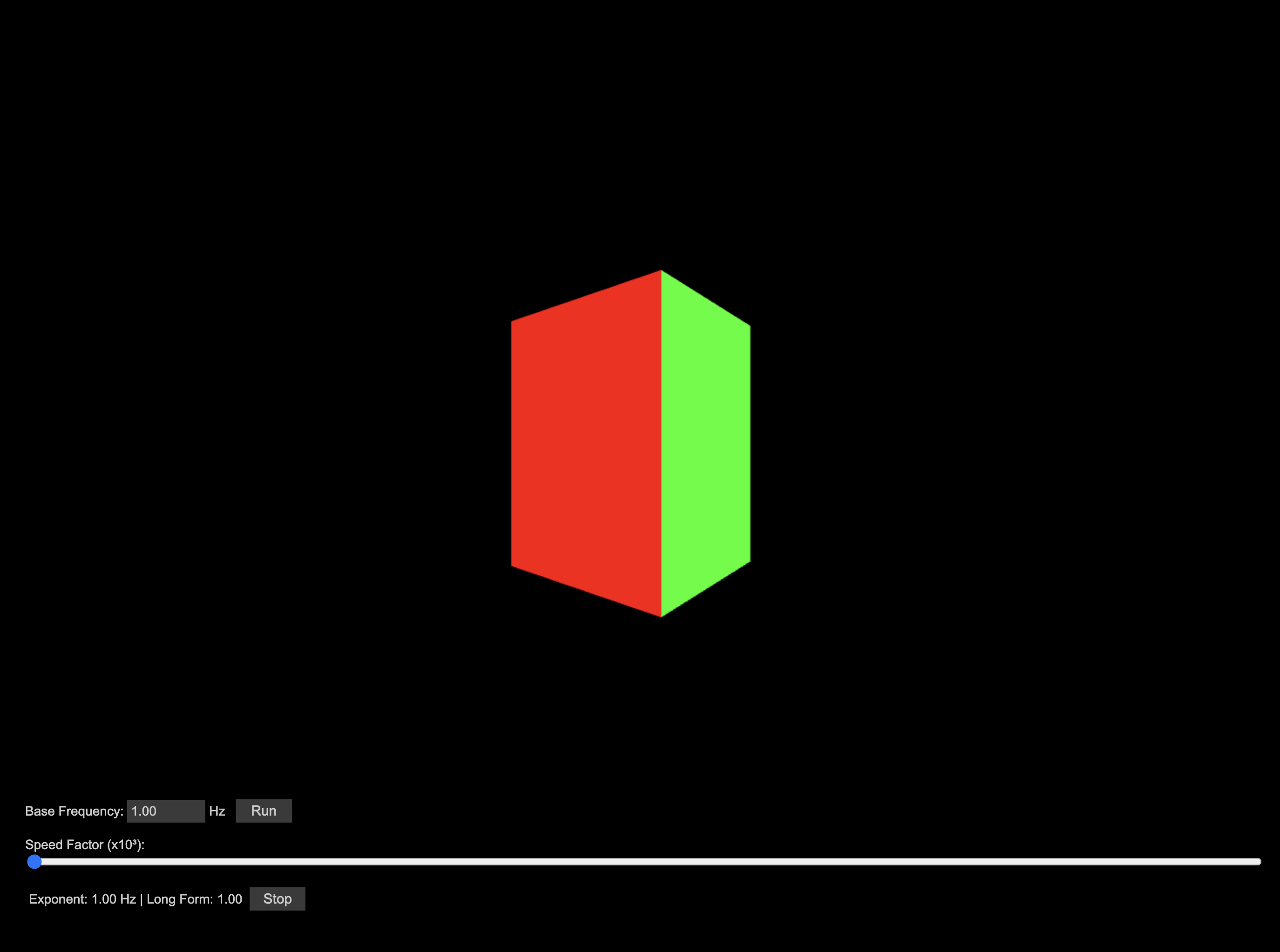Scaled Velocity as Superposition
A Github repository of this and anharmonic wave simulations will be availble after publication. In the mean time, the following is a concise example of the concept of scaled velocity as a superposition of options for a slower timebase.
Open the file farhatPrism.html in a separate window.
This live simulation of a spinning prism is designed to illustrate the concept of superposition as a result of velocity.
Before running, first enter a base frequency for the rotation. It is currently set for 1.00 Hz. Our exponent slider increases by a factor of x10³. Instead, let's enter a base frequency of 0.333333 Hz.
When RUN, a 3D prism appears and begins a number of full rotations per second, according to the "Base Frequency" setting. For instance if 1.0 Hz is used as the Base Frequency, that would mean one full 360 rotation per second. The prism continues to rotate at the Base Frequency rate, until the Exponent Slider is moved.
- Each of the three faces represents one each of
Red,GreenandBlue, each as 100% hue. - Red RGB value = 100,0,0
- Green RGB value = 0,100,0
- Blue RGB value = 0,0,100
- Playback frame rate is 100 fps. With adequeate RAM, this should play at speed in Google Chrome.
- In additive color mixing, equal amounts of red, green, and blue light merge to create white light.
We'll try to force a strobing effect by entering a base frequency of 0.333333 Hz for the rotation.
Press Run.
Notice the prism slowly rotates counter clockwise or as angular momentum would have it, upward. We'll use this to represent our observable universe and timebase.
Slider step #1
Since we haven't scaled our velocity yet, out "Exponent" slider shows Exponent: 1.00 Hz | Long Form: 1.00.
Now slowly pull the exponent slider to the next increment on the right. Each increment step increases speed by a factor (x10³).
Exponent: 3.33e+0 Hz | Long Form: 3.33333
We've only trippled its speed, but not fast enough for the additive color combination effect to appear. We clearly see a R-G-B pulse.
Slider step #2
Now pull the slider to the next step.
Exponent: 3.33e+1 Hz | Long Form: 33.3333
This begins to produce the effect of a white prism on all three sides due to the additive color combination effect of the RGB primaries. Though the prism remains stable, each face is cycling over 33 times a second but blending to white based on the equal combination or red, green and blue at the right phase in time.
If you were to hit the Stop button, you would freese the rotation at that point. Notice you can hit the button multiple times, and the same face can appear either red, green or blue, depending on when we collapsed the accelleration. We have create a superposition of eigenstates. You will notice over time that the prism actually appears to rotate very slowly in the opposite direction due to the ‘strobing effect where the framerate is out of phase with the animation timebase’.
Slider steps #3,4
Now pull two more steps to the right.
Exponent: 3.33e+3 Hz | Long Form: 3,333.33
Prism appears to begin rotating counter to its base rotation. Still, the sides remain white, and stopping and starting at any time shows different eigenvalues. The gradual rotation is just the beginning of the strobbing or 'wagonwheel effect' as our 100 fps time base beginning to conflict with the higher resolution of the object rotation. This is not a point of this simulation, but we are using the effect to illustrate the variance of viewing platforms.
Most importantly, the vision of a stable object, highly oscillating internally until observed, ie: the Stop button, shown here to illustrate the concept of wave function collapse. But in this case... collapsing one velocity base into another.
Slider steps #5,6
Next to Exponent: 3.33e+5 Hz | Long Form: 333,333
Ignoring the rotation for the moment, (The prism appears to rotate slightly faster), we have an object still appearing to be a stable white solid. Hitting the STOP and START button multiple times reveals that any side, can be any value at almost any time, relative to our timebase of 100 fps. But no each face has over 333 thousand possible outcomes, or 111 thousand possible times per second each of the three RGB colors could appear on any of the three geometry facets.
Next to Exponent: 3.33e+11 Hz | Long Form: 333,333,000,000
Now our phase has changed to show a stable RGB prism, except now each of the facets has over 333 billion possible outcomes for the observer, this appears to be a stable and gently rotating prism, which instead is a superposition of Red Green and Blue faces as possible outcomes, scaled to by a factor of 333 billion : 1. In this case, we illustrate that with just a change in the phase of our viewing perspective, scaled time base velocities can form superpositions.